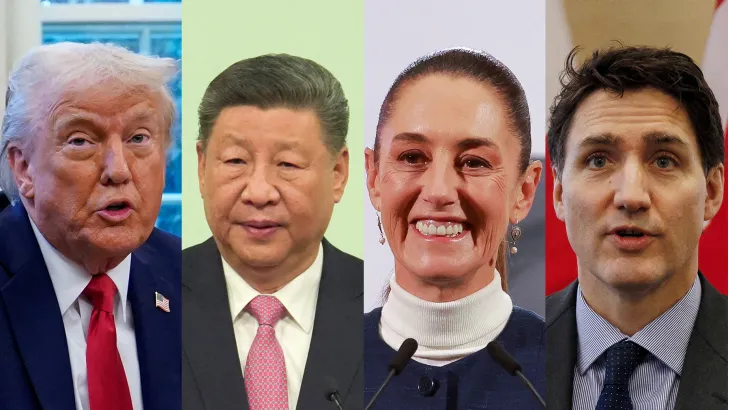- China has placed counter tariffs on US imports that will come into effect on February 10 after President Donald Trump placed 10 percent levies on Chinese goods.
- Mexico’s President Claudia Sheinbaum and Canada’s Prime Minister Justin Trudeau have announced a 30-day suspension on US tariffs after an agreement was reached with Trump.
- The Mexican and Canadian leaders have agreed to send thousands of police to their borders with the US to fight drug trafficking and undocumented migration.
- The Trump administration has locked US Agency for International Development (USAID) workers out of their headquarters in central Washington, DC, as it moved to close the agency.
- Democrat lawmakers have questioned the legality of billionaire Elon Musk’s role in sweeping changes at key US federal government bodies, including Treasury and USAID.
- A judge in Washington, DC has extended an order pausing Trump’s plan to freeze potentially trillions in US federal government spending.
- EXPLAINERThe long US history of tariff wars with Canada and the worldFor all the chaos that Trump has unleashed, he isn’t the first US president to wage tariff wars.In fact, he is following in steps of a series of predecessors who tried to use tariffs as a bludgeon to get other countries to follow Washington’s interests.What happened in those instances? Who were the key players involved? And what is Trump’s rationale for trying to impose tariffs?Read more here.

- Empty shelves remain with signs ‘Buy Canadian Instead’ in Vancouver, British Columbia, Canada, on February 2, 2025 [Chris Helgren/Reuters]
- Asian stock markets climb despite US-China tariffsAsian shares have climbed even as US tariffs on China came into effect and China imposed retaliatory measures on the US.Stocks across Asia were up today, with the Hang Seng Index in Hong Kong growing 2.10 percent to 20,642.58.Japan’s benchmark Nikkei 225 was up 1.61 percent to 39,140.41, while South Korea’s Kospi grew 1.63 percent to 2,493.99. Australia’s S&P/ASX 200 rose 0.13 percent to 8,390.20.

- People walk in front of an electronic stock board showing Japan’s Nikkei index at a securities firm on Tuesday, February 4, 2025, in Tokyo [Eugene Hoshiko/AP]
- China retaliation leaves room for ‘last-minute diplomacy’Julien Chaisse, a professor at City University of Hong Kong who specialises in international economic law, has told Al Jazeera’s Asia Business Editor John Power that the choice of a February 10 start date for China’s retaliatory tariffs appears strategic.“It allows time for a possible discussion between Trump and Xi which is creating space for last-minute diplomacy before the measures take effect. Beijing likely wants to signal resolve without foreclosing the possibility of a negotiated off-ramp,” he said.“If talks between the two leaders occur in the coming days, there is room for adjustments, partial exemptions or reciprocal gestures that could prevent a further spiral in trade tensions,” Chaisse added.However, much will depend on Washington’s interpretation of these measures, he said.“If the US views them as a calibrated step leaving room for negotiation, this could set the stage for discussions rather than further escalation. However, if Trump sees this as a direct challenge, his administration could respond with additional trade restrictions; this would intensify the conflict,” Chaisse said.“I think that the next key indicators will be whether China escalates beyond tariffs; for instance by tightening restrictions on US companies in strategic sectors; or if it keeps its response largely within the trade sphere. If Beijing refrains from broader economic countermeasures, it signals that negotiations remain a priority.”
- Beijing uses lessons learned from first Trump administrationReporting from Beijing, ChinaThis is the second time around for China in dealing with Trump tariffs.Even if we look at this recent example of tariffs on Canada and Mexico, it seems that China has observed that situation and seen that perhaps there is some room for negotiation here.If we look at the broader US-China relationship, and particularly the escalation in tensions that emerged during the first Trump administration, China did learn some difficult lessons.Part of that has resulted in diversification, looking at trade opportunities outside of the US sphere. We’ve seen an expansion of trade ties between China and the ASEAN countries in Southeast Asia, in addition to ties with Central Asia and Africa.There will be some hurt to Chinese businesses, particularly to those with a stronger presence in the US market, but many of them have already made adjustments, for example, moving some of their manufacturing operations to Vietnam and Malaysia.
Trump tariffs live: China retaliates with levies; Mexico, Canada seal deal
















